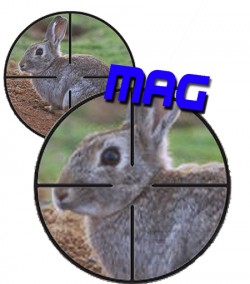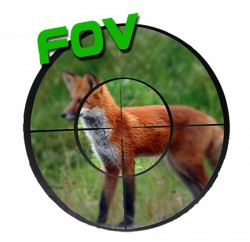The Physics of Optics
There is no free lunch when choosing the right scope
Three important aspects of scope design can have major effects on the image you see.
This article covers eye relief, magnification, field of view – and how all three will impact your shooting.
In this blog I’ll be exploring some of the strengths and limitations of scope manufacture, how these factors impact upon the viewed image and impact upon each other. I will also look at what this means for you, the shooter, while along the way dispelling some of the more common myths surrounding optics.
The ‘big three’ factors of scope design (eye relief, magnification and field of view) are bound by physics and virtually un-cheatable. You can’t have a scope heavily weighted in one factor without losing in one or both of the others. For example, you cannot have a scope with extremely high magnification without having a short eye relief or a narrow field of view (or both!). There are many other areas of scope design (ruggedness, weight, objective bell diameter, optics quality, windage and elevation adjustment, etc.) which will also affect your decision when choosing a scope that is right for you, but in this article I will only be focusing on the big three.
1. Eye relief
Eye relief is the distance from the ocular lens to your eye, usually measured in inches. The optimal distance from the scope where the shooter will observe a full, clear image is called the ‘Eye Box’.
This optimal eye relief may vary between two distances from the ocular lens (for example, 3.5” to 4” from the ocular lens on a scope suited to hunting) and have a small amount of wiggle room both up and down and left and right, in which a full and clear image can be observed – this is why is why it is called a ‘box’ not a ‘point’.
Optics are manufactured with different lengths of eye relief depending on the intended application of the scope. If you look at the images above, you will notice that scout rifle scopes have an extremely long eye relief, conventional scopes have a much shorter eye relief, while binoculars have an extremely short eye relief. Generally speaking, the eye relief on a long relief scope is less critical than on a short eye relief scope and much less critical than a set of binoculars – it is quicker and easier to get a full and clear image on a long eye relief scope than a short eye relief scope.
How does this affect other factors in the optical triangle?
For a certain magnification, increasing the optimal eye relief distance will restrict field of view. Shortening eye relief will increase field of view. Think about eye relief like peeping through a keyhole – the closer you are to the key hole the more you can see. The further back from the keyhole you are, the less field of view that you have and the less you see.
Eye relief is a fixed length which manufacturers do not allow the client to modify (except for long eye relief scout scopes or handgun scopes). Each optic manufacturer will make products suited to particular styles of shooting and therefore the eye relief of their scopes will differ from other manufacturers. So the only way a shooter can choose a scope with a certain eye relief is by brand.
It makes sense on a rifle that has a large amount of recoil, or a situation where the shooter is required to take a quick shot, that a scope with longer eye relief would be more suitable. In contrast, a target shooter, who may have no time restrictions, shooting a heavy rifle with little recoil, would be able to use a scope with shorter eye relief.
Always choose a scope that has sufficient eye relief to allow the rifle to be shot from various shooting positions without risking injury to the shooter.
2. Magnification
Magnification in a scope can usually be adjusted. During the middle to late twentieth century, many hunters chose to use optics with no magnification adjustment (‘fixed power’) because of the risk of magnification adjustment shifting the point of impact, or malfunctioning and rendering the scope unusable. Modern methods of scope manufacturing have mastered the variable magnification system and today, changes in point of impact due to magnification adjustment are almost unheard of. Consequently, almost all modern scopes have adjustable magnification.
How does magnification effect the other factors in the optical triangle?
Increasing the magnification of the scope increases the image size. Therefore, for a certain eye relief the field of view will decrease. So while the image appears larger, it is harder to see what is around and behind the target and it is also harder to track the target if it were to move.
By increasing magnification the eye relief is generally made shorter and more critical. This makes it harder for the shooter to position their head in the optimal position for a crisp, clear image.
Scopes are manufactured with different ranges in magnification for different purposes. A higher magnification is required for shooting smaller objects, objects that are further away and for taking more precise shots. Lower magnification is required for shooting larger objects, objects that are closer, objects that are moving and for when precision is less important.
For example, a shooter that needs to take a shot at a running pig at ranges shorter than one hundred meters would only need a low magnification scope. Varmint shooters, however, shooting foxes at two or three hundred meters, can sacrifice field of view for greater magnification in order to identify the smaller target at longer ranges.
3. Field of View
Field of view is the diameter of the image that appears through the scope, usually measured in feet at 100 yards. Field of view is a linear measurement – for any given eye relief and magnification, field of view at 100 yards will be one tenth of that at 1000 yards.
How does field of view effect the other factors in the optical triangle?
Field of view is a function of the other two factors in the optical triangle – while eye relief and magnification can be varied by using different components and spacing them within the scope differently, field of view can only be changed by modifying one of the other two functions.
If a wider field of view is required, the scope must be able to be adjusted to a lower magnification or it must have a shorter eye relief (such as in the keyhole example above).
Always choose a scope with an eye relief and magnification range that allows for a field of view wide enough that you can discern what the projectile will hit if you miss the target.
These three factors are governed by the laws of physics and are impossible to change. There is no free lunch – in order to increase one you have to decrease one or both of the others. Scope manufacturers have attempted to create rifle scopes that give shooters more variation in these three factors by introducing scopes with larger magnification ranges. For example, instead of the 3x magnification of the Leupold VX-1 series (2-7, 3-9 or 4-12 magnification ranges) the Leupold VX-6 features a 6x magnification range (1-6, 2-12, 3-18, 4-24, 7-42). This allows for a generous eye box and wide field of view for quick shooting on the lower magnification ranges, and precision shooting at the higher magnification ranges.
Myths
Because of the limited information available there are many myths surrounding scopes and their capabilities. I will try and dispel a couple of the more common ones surrounding magnification and field of view.
- No gun can be held perfectly still. Items such as rests and vices attempt to mitigate movement for more accurate shooting, but the gun almost always has some degree of movement. Increasing the magnification of a scope has no effect on accuracy of the firearm – it only helps the shooter place the shot in the correct position.
- Field of view is not effected by objective bell diameter. A 3-9×40 and a 3-9×50 rifle scope, given the same eye relief, will have identical fields of view. If you think about the keyhole example, placing a 40mm piece of tube or a 50mm piece of tube over the key hole does not affect the field of view. Proof of this is the Leupold VX-3L series of scopes – the objective bell size and shape has no effect on the size or shape of the viewed image – VX-3L scopes do not project a crescent shaped image!
Every shooter is going to vary slightly in exactly what they expect to get out of a rifle scope – picking the right one is a difficult task. I hope this article will help you choose your next rifle scope.
– Zaine Beaton
If you wish to comment or provide feedback on Zaine’s blog you can contact him via the email address – zaine@beatonfirearm.onpressidium.com
This email address is for contacting Zaine in direct relation to blog articles only – not for general correspondence or sales inquiries. For sale inquiries, please visit our Contact Us page, which can be found at the top of the page.
Please keep in mind that these are Zaine’s personal comments – they are not a reflection of the opinions of any other staff or directors of Beaton Firearms.




